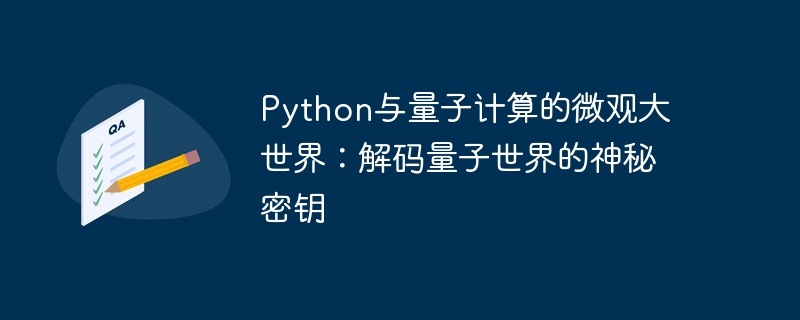

1. The charm of quantum computing: the big secret of the microscopic world
Quantum computing relies on qubit operations to achieve calculations, and the quantum state can be in a superposition state and can present multiple states at the same time. Through quantum superposition, quantum entanglement and other characteristics, quantum computers can process massive amounts of information at unimaginable speeds. At the same time, quantum computers can also help solve some problems that are difficult for traditional computers to overcome.
2.Python: A powerful “assistant” for quantum computing
pythonWith its versatility, powerful libraries and toolsbox, it has become an ideal choice for studying quantum computing. Including a flexible syntax, a rich scientific library, and an active and supportive community, Python provides a solid foundation for quantum computing. Therefore, Python is often used in the research of quantum algorithms, quantum programming, quantum simulation and quantummachine learning fields.
3. Quantum algorithm and effect demonstration implemented in Python
Demonstration 1: Using Python to implement the classic Deutsch-Jozsa algorithm
import numpy as np
# 创建一个使用随机比特生成器初始化的量子寄存器
qubits = qiskit.QuantumReGISter(2)
# 创建一个经典寄存器来存储结果
classical_bits = qiskit.ClassicalRegister(1)
# 创建一个量子电路
circuit = qiskit.QuantumCircuit(qubits, classical_bits)
# 应用Hadamard门到第一个量子比特
circuit.h(qubits[0])
# 应用受控NOT门到第一个和第二个量子比特
circuit.cx(qubits[0], qubits[1])
# 应用Hadamard门到第一个量子比特
circuit.h(qubits[0])
# 测量量子比特并存储结果
circuit.measure(qubits[0], classical_bits[0])
# 使用模拟器运行电路
job = qiskit.execute(circuit, qiskit.Aer.get_backend("qasm_simulator"))
# 从结果中获取测量结果
result = job.result()
# 打印测量结果
print(result.get_counts())Demo 2: Using Python to implement Grover’s search algorithm
import numpy as np
from qiskit import QuantumRegister, ClassicalRegister, QuantumCircuit, execute
# 创建一个包含n个量子位的量子寄存器
qubits = QuantumRegister(n)
# 创建一个包含一个经典位的经典寄存器
classical_bit = ClassicalRegister(1)
# 创建一个量子电路
circuit = QuantumCircuit(qubits, classical_bit)
# 初始化量子寄存器
circuit.h(qubits)
# 应用Grover运算符
circuit.oracle()
circuit.h(qubits)
circuit.x(classical_bit)
circuit.h(qubits)
circuit.oracle()
circuit.h(qubits)
# 测量量子寄存器
circuit.measure(qubits, classical_bit)
# 使用一个模拟器来执行电路
backend = Aer.get_backend("qasm_simulator")
job = execute(circuit, backend, shots=1024)
# 获取测量结果
result = job.result()
counts = result.get_counts()
# 打印测量结果
print(counts)4. Conclusion: Python and the future prospects of quantum computing
The combination of Python and quantum computing provides strong power and vitality for quantum research and development. In the future, quantum computing will play an important role in various fields, including cryptography, artificial intelligence , materials science and finance, etc.
The above is the detailed content of Python and the microscopic world of quantum computing: decoding the mysterious key to the quantum world. For more information, please follow other related articles on the PHP Chinese website!




